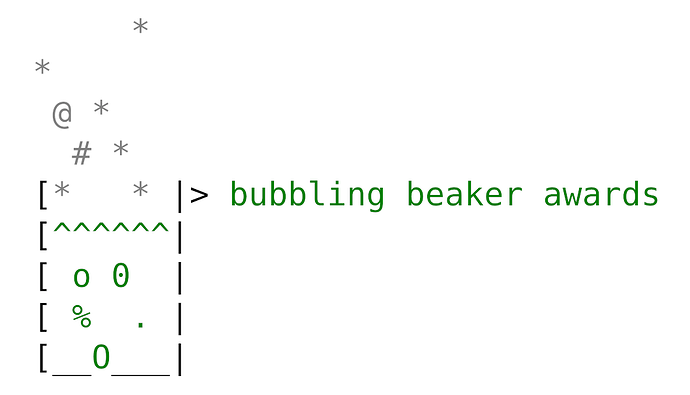Every other week, I (and/or a democratic anarchist mob of other mad scientists) will choose an outstanding example of I7 mad science (favoring recent activity) and link to it here.
The “Rules”1
To qualify as “mad science,” a winning post should almost certainly:
- contain compilable code
- achieve the original poster’s goal better than any other posted solution
A winning post should also preferably:
- use a technique never before conceived (or at least never before demonstrated on the forum)
- deploy I6 inclusions, techniques from later chapters of Writing with Inform, or “hacks” intended to skirt compiler limitations
- provoke gasps of alarm, cries of outrage and/or sinister chuckles
The winning entry need not be accepted as the solution to the posted problem – it is taken as a given that the general populace may fail to appreciate the genius on display. Additionally, the winner need not be an MSC member, though preference will be given to members in order to minimize the risk of accidental insult.
Nominations
Anyone, member or not, is free to send a direct message the group to nominate a particular post (preferably on a Wednesday or Thursday). If MSC members make a substantial show of support for a particular candidate, that week’s award will be further distinguished as Peer Revued™.
Note that for the inaugural post, two awards were given because it seemed fitting that the first post to earn the award (numbered zero for technical reasons) should be publicly recognized.2
Winners’ Privileges
Winners are invited to discuss the details of their winning invention here – including how it works, why it works, and (by way of cautionary tale) the circumstances of its inspiration and conception – for the edification of users of Inform and to promote the mad science ethos at large.
>FOOTNOTE 1: As with all things mad science, the prescribed rules are entirely optional and likely to be ignored, scorned and/or forgotten whenever convenient.
>FOOTNOTE 2: Yes, this means that first winner managed to earn the award over 4 months before it even existed. “Impossible” results are the hallmark of mad science at its best!
THE LEADERBOARD
Following is a list of award recipients and the number of awards received to date. In cases where the number of awards is identical, individuals are listed in the order by which they first reached that number. An asterisk after the username indicates that at least one award has been granted the Peer Revue™ distinction.
WINNER AWARDS LAST AWARD DATE
----------------- ------ ---------------
drpeterbatesuk* 4 Feb 23 2024
Draconis 4 Mar 22 2024
Zed* 4 Apr 05 2024
matt_weiner 2 Feb 09 2024
CrocMiam 1 Sep 01 2023
evc003 1 Sep 15 2023
BadParser 1 Sep 29 2023
SJ_43 1 Oct 13 2023
Dannii 1 Oct 20 2023
capmikee 1 Nov 17 2023
eu1 1 Dec 29 2023
otistdog* 1 Jan 26 2024
borg323 1 Mar 08 2024
Celtic_Minstrel 1 Apr 19 2024
>CREDITS: The Bubbling Beaker Awards® header image and the mad-scientists flair icon image were created by FLACRabbit (author of A Matter of Heist Urgency).
2023
-
April 2023
- Award #0 (Apr 7): Zed for Meaning relation and reversed relations - #6 by Zed [retroactive]
-
August 2023
- Award #1 (Aug 25): drpeterbatesuk for Changing what something is "understood" as to a list of multiple words? - #3 by drpeterbatesuk
-
September 2023
- Award #2 (Sep 01): CrocMiam for Sorting a list of things in "(decide which number is)" order - #3 by CrocMiam
- Award #3 (Sep 08): Draconis for Listing Non-Objects
- Award #4 (Sep 15): evc003 for How to make a one-way connection going sideways instead of up or down? - #7 by evc003
- Award #5 (Sep 22): Zed for Accessing a list of a single property of multiple things - #12 by Zed [Peer Revued™]
- Award #6 (Sep 29): BadParser for How to pass an argument to a custom command? - #11 by BadParser
-
October 2023
- Award #7 (Oct 06): drpeterbatesuk for Lack of randomness sometimes when compiling for Glulx - #77 by drpeterbatesuk [Peer Revued™]
- Award #8 (Oct 13): SJ_43 for I7: The Trouble with Npcs (Part 1) - #5 by SJ_43
- Award #9 (Oct 20): Dannii for Data Structures extension
- Award #10 (Oct 27): matt_weiner for I6: How to copy an array from a local to global? - #3 by matt_weiner
-
November 2023
- Award #11 (Nov 03): Draconis for Commanding multiple actors at the same time - #27 by Draconis
- Award #12 (Nov 17): capmikee for Developing a new conversation extension - #18 by capmikee
-
December 2023
- Award #13 (Dec 01): Zed for Problematic parsing of possessive pronouns for parts of people - #3 by Zed
- Award #14 (Dec 15): drpeterbatesuk for Bubbling Beaker Awards (Award #23, Apr 19 2024) - #40 by drpeterbatesuk
- Award #15 (Dec 29): eu1 for [I7] Understanding a property as one of its properties - #4 by eu1
2024
-
January 2024
- Award #16 (Jan 12): Draconis for Time to Reinvent the Route-Finder - #40 by Draconis
- Award #17 (Jan 26): otistdog for Correctly parsing "light light light" - #4 by otistdog [Peer Revued™]
-
February 2024
- Award #18 (Feb 09): matt_weiner for Giving NPCs attitudes toward topics of conversation - #9 by matt_weiner
- Award #19 (Feb 23): drpeterbatesuk for Player's command including a (text) variable - #15 by drpeterbatesuk
-
March 2024
- Award #20 (Mar 08): borg323 for Z-Machine 1.2 Proposal (again) - #30 by borg323
- Award #21 (Mar 22): Draconis for Re-printing text that was printed earlier - #7 by Draconis
-
April 2024
- Award #22 (Apr 05): Zed for Inform7/10 Reference Manual - #47 by Zed
- Award #23 (Apr 19): Celtic_Minstrel for Can relation properties be defined in assertions? - #7 by Celtic_Minstrel
-
May 2024
- Award #24 (May 03): TBD
